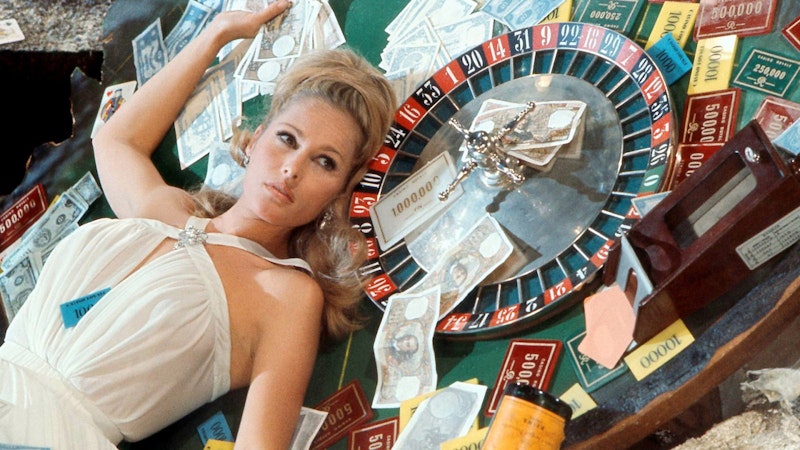By 1967 James Bond was big business. Four massively popular films were released in the previous five years. Although creator Ian Fleming died in 1964, Kingsley Amis was at work on a new Bond novel authorized by the rights-holders. There were toys, soundtrack albums, a daily comic strip in the UK. And movie-goers in 1967 were treated to two separate adaptations of Fleming novels. The second would be one of the ongoing series of films starring Sean Connery; the first, an adaptation of the initial Bond novel Casino Royale, was something a lot more bizarre.
In isolation the 1967 Casino Royale adaptation is a weird beast, lurching from plot point to plot point with the barest nod to coherency. It opens with M (John Huston) and a deputation of international worthies trying to coax retired secret agent James Bond (David Niven) to destroy the espionage organization SMERSH. Bond refuses until a SMERSH bomb destroys his house and kills M.
After an extended interlude in which Bond delivers the news of M’s death to his widow, he hatches a scheme to create a number of Bond duplicates to smash SMERSH. A variety of disconnected set-pieces follow. Eventually one of the Bond duplicates, played by Peter Sellers, stumbles into a plot something like the book and plays a deadly game of cards with the villainous Le Chiffre (Orson Welles) who turns out to be the pawn of a greater villain. Assorted running-around ensues, involving a flying saucer and at least one dream sequence. It ends up with a climax in the Casino Royale in which oddballs show up for no obvious reason (Frankenstein’s monster! Random Indigenous Americans! The Keystone Kops!).
You can see the novel buried in there if you squint, but audiences at the time could be forgiven for asking: what just happened? And the answer, briefly, is: copyright law.
Fleming sold the film rights to Casino Royale in 1955, but producer Gregory Ratoff was unable to get a film made before the successful Bond series from Eon Productions came along. After Ratoff died, agent Charles K. Feldman ended up with the rights but couldn’t come to an agreement with Eon productions to make a Royale movie. He therefore had veteran screenwriter Ben Hecht write a script, and approached Columbia to get his own adaptation going. And this is where it gets weird.
Hecht did some drafts of the script, then died of a heart attack and Joseph Heller took over writing—only briefly, then everything was rewritten by Billy Wilder before Wolf Mankowitz was brought in (along with John Law and Michael Sayers, who with Mankowitz ended up as the credited writers). By this time Feldman had decided that if he couldn’t work with Eon, he’d send up their Bond and the spy-story craze Bond had inspired. He hired Sellers, who rewrote his own scenes.
The cast expanded, but Sellers was difficult to work with (rumors flew of a dispute with Welles, and of disappointment Sellers wasn’t playing a serious Bond), so with much of the movie shot he was fired and the script rewritten. That led original director Joe McGrath, a friend of Sellers’, to also be let go; at which point the idea developed to hire four other directors (Huston, Ken Hughes, Robert Parrish, and Val Guest) to shoot various chunks of the rest of the movie. The plan was to make something in the vein of It’s A Mad, Mad, Mad World, the 1956 Around the World in 80 Days, or The Great Race: sprawling madcap comedies with cameos and set-pieces.
It doesn’t come together even slightly, which is startling given the level of talent. In addition to the names mentioned so far (Welles! Sellers! Wilder! Huston!), there are substantial roles for Woody Allen, Ursula Andress, Deborah Kerr, and a young Jacqueline Bisset. There are cameos from Peter O’Toole, William Holden, Jean-Pierre Belmondo, Charles Boyer, and Derek Nimmo. Among the three credited cinematographers is Nicolas Roeg; Burt Bacharach did the music.
And it doesn’t work. There are some nice moments, particularly a Berlin-set expressionist sequence featuring Bond’s daughter (Mata Bond, played by 25-year-old Joanna Pettet though the character’s mother died in 1917). Peter Sellers tries. David Niven effortlessly outclasses the material, playing a character less James Bond than an aged aristocratic Sherlock Holmes.
But beyond a couple of scattered moments, it’s not funny. There’s an odd absence of punch lines; when they do arrive you regret it. It’s not even good as camp. At best, usually when Sellers is onscreen, it’s watchably absurd. The very haphazardness at least means you have no idea what comes next, but it’s clear that too many people didn’t really care about the movie. An attempt at an explosive finale seems slapped on because after two hours and 11 minutes it has to end somehow.
It doesn’t work as satire, either. Niven’s Bond has a couple of cutting lines about “that bounder to whom you gave my name and number,” and the bounder’s reliance on gadgets, but there isn’t any insight into the nature of the Bond stories. The movie doesn’t know what’s worth sending up; notably, it’s arguably more misogynistic or at least exploitative than the Eon Bond films.
The film may want to be a response to the pop image of Bond, but it feels so un-Bondlike any parody’s nullified. Still, as an attempt at parody, however poor, it might have qualified as fair use under copyright law; you wonder what the advantage was of having the rights. But for all its flaws, and despite a hostile critical reception, it still made back well over three times its budget. Which is enough of an answer for a movie like this.

